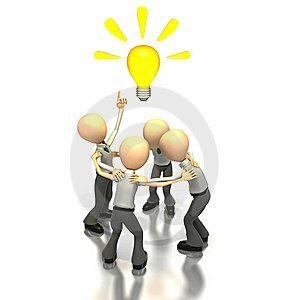The value chain It is a theoretical model that graphs and allows to describe the activities of an organization to generate value to the end customer and to the same business.
The questions we ask ourselves when we study this theory are: How is it possible to create value based on the inputs of the value chain? How can we increase the margin of our commercial activity? They seem like ordinary questions, but they are the essence of business life in the world.
Advertisements
Manufacturing industries create value since they transform the raw Materials in products of necessity for people. A retail retail company offers a wide variety of products, a concept with which it creates value for him consumer since it offers everything in one place. A mining company uses natural and industrial resources to extract minerals on a large scale. And so an infinity of companies and items work day by day to generate the much appreciated margin.
Based on this definition, it is said that a company has a competitive advantage
Advertisements

In this article you will find:
Description of Michael Porter's Value Chain
Each company is a set of activities that are carried out to design, produce, bring to market, deliver and support their products. All these activities can be represented using the value chain, as you can see in the figure shown at the end of the article.
Advertisements
 The value chain displays the total value, and consists of the value and margin activities. Here are some key definitions for understanding the concept:
The value chain displays the total value, and consists of the value and margin activities. Here are some key definitions for understanding the concept:
Margin: It is the difference between the total value and the collective cost of performing the value activities.
Value Activities: They are the different activities carried out by a company. They are divided into two broad types:
Advertisements
- Primary activities: Primary activities in the value chain These are the activities involved in the physical creation of the product, its sale and transfer to the buyer, as well as post-sale assistance. They are in turn divided into the five generic categories that can be seen in the image.
- Internal logistics: The first primary activity in the value chain is internal logistics. Companies need to manage and administer in some way the activities of receiving and storing the raw materials necessary to make your product, as well as the way to distribute the materials. The more efficient the internal logistics, the greater the value generated in the first activity.
- Operations: The next stage in the value chain is operations. Operations take raw materials from inbound logistics and create the product. Naturally, the more efficient the operations of a company, the more money the company can save, providing added value in the bottom line.
- External Logistics: After the product is finished, the next activity in the value chain is outbound logistics. This is where the product leaves the center of production and is delivered to wholesalers, distributors, or even end consumers depending on the company.
- Marketing and sales: Marketing and sales is the fourth primary activity in the value chain. Here you have to be careful with advertising expenses, which are a fundamental part of sales.
- Services: The final activity of the value chain is service. The services cover many areas, ranging from the management of any facility to customer service after the sale of the product. Having a strong service component in the supply chain provides customers with the necessary support and trust, which increases the value of the product.
- Support Activities: In the Michael Porter Value chain, the support activities are those that sustain the primary activities and support each other, providing purchased inputs, technology, human resources, and various functions across the entire business. The dotted lines reflect the fact that sourcing - purchasing -, technology and management of Human resources can be associated with specific primary activities as well as chain support complete. The infrastructure is not associated with any of the primary activities but supports the entire chain.
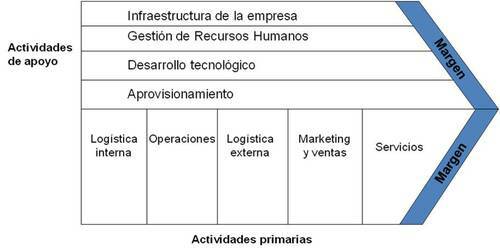
Interaction of the value chain with the system
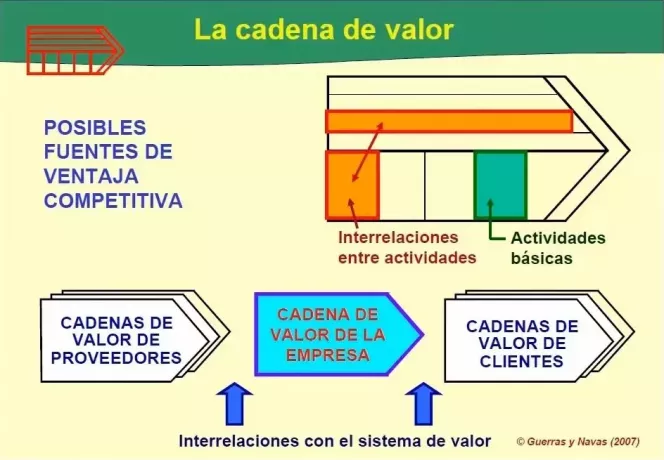
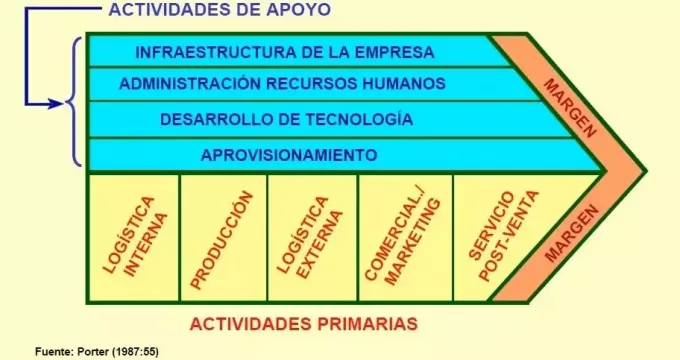 The value chain of a company, as we said before, is represented graphically by a polynomial, which graphs the activities independently. In reality these activities are not independent, since they interact with other «value chains» (customers and suppliers).
The value chain of a company, as we said before, is represented graphically by a polynomial, which graphs the activities independently. In reality these activities are not independent, since they interact with other «value chains» (customers and suppliers).
Advertisements
Relationship with competitive advantage
The valuable activities they are the unobtrusive partitions of competitive advantage. As each activity is performed in combination with its economy, it will determine if a company has a high or low cost in relation to its competitors. How each valuable activity performs will also determine the contribution to the buyer's needs and therefore to differentiation. Comparing competitors' value chains exposes differences that determine competitive advantage. The value chain in strategic terms it is a powerful tool that should be used by any strategist.
As Guerras and Navas say in the video attached at the end of the article, competitive advantage can be achieved in two ways:
- Through link optimization
- Through an improvement in the coordination of the links
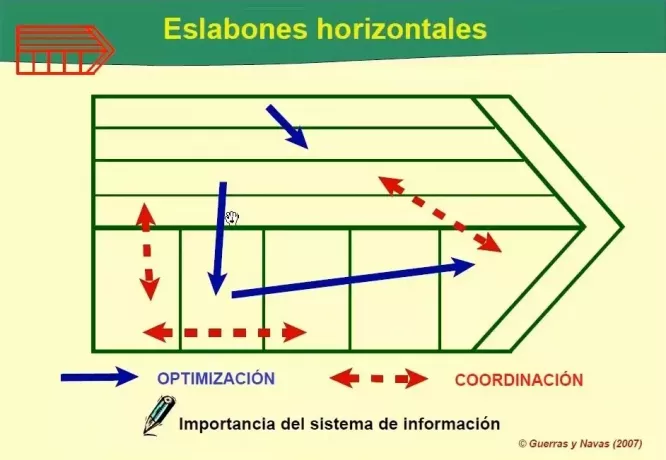 Application of the model
Application of the model
To identify and understand the value chain in the company, we recommend that you follow these steps.
Step 1 – Identify the sub-activities for each main activity
For each core activity, determine which specific sub-activities create value. There are three different types of subactivities:
Direct activities: create value for themselves. For example, in the marketing and sales of a publisher's activity, direct subactivities include making sales calls to bookstores, advertising, and selling online.
Indirect activities- Allow direct activities to run smoothly. For sales and marketing of the publisher example, indirect sub-activities include managing the sales force and maintaining customer records.
Quality assurance activities: they ensure that direct and indirect activities meet the necessary standards. Continuing with the book publisher's sales and marketing example, this could include revision and edit announcements.
Step 2 – Identify the sub-activities for each support activity.
For each of the support activities such as Human Resources management, Technological Development and Acquisitions, it is necessary to determine the sub-activities that create value within each main activity. For example, consider how human resource management adds value to inbound logistics, operations, outbound logistics, and so on. As in step 1, look for the direct, indirect, and quality assurance subactivities.
Step 3 – Determine the links.
Find the connections between all the valuable activities you have identified. This will take time, but linkages are key to increasing competitive advantage in the value chain. For example, there is a link between sales force development (an investment in human resources) and sales volumes. There is another link between response times, and for service phone calls from frustrated customers waiting for deliveries.
Step 4 – Look for opportunities to increase value.
Review each of the sub-activities and links that has identified you, and think about how it can be changed or improved to maximize the value it offers to clients (clients of both internal and external support activities).
Some tips for applying the value chain
Tip 1:
The your organization's value chain it should reflect business strategies. Therefore, when deciding how to improve your value chain, you must be clear about the characteristics that differentiate it from its competitors or simply have a cost structure more low.
Tip 2:
You inevitably end up with a huge list of change proposals. Prioritize changes and focus on the ones that impact the customer the most.
Tip 3:
This article analyzes the value chain from a broad point of view, that is to say strategic. So it is important to go into more detail about each of the steps mentioned above.
Tip 4: The value chain is fundamentally an internal analysis of the company, so it is also convenient to carry out an external analysis using tools such as Porter's 5 forces or the SWOT.
